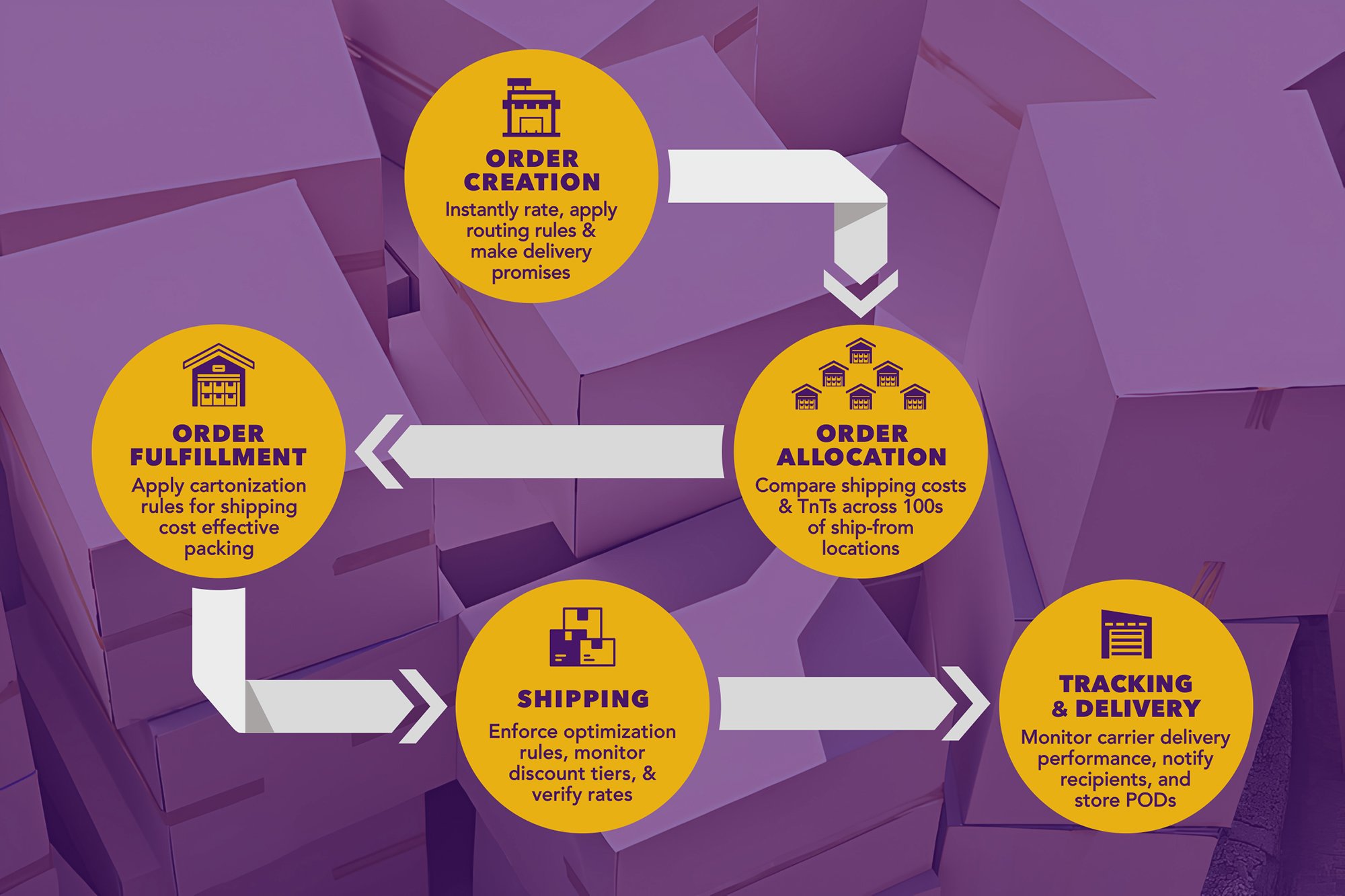Upstream Parcel TMS Optimization Drives Cost-Effective Downstream Outcomes
Before eCom marketplaces pushed shippers toward omni-channel fulfillment and carrier diversification, parcel management was pretty straightforward: choose a national carrier, negotiate annual rates, and automate label printing at the end of the conveyor belt.
Today, parcel market is more volatile and far more complex. Carrier pricing is cryptic, with an ever-growing list of surcharges and hidden fees. The result? A widening gap between expected shipping costs and actual carrier invoices that impact profit margins. Shippers need to automate decisions about where, when, and how they use carrier services—across the entire order-to-invoice lifecycle.
Waiting until an order is weighed and labeled at the end of a conveyor is waiting too late.

Digital Storefronts: Speed, Choice, Cost, and Promise Matter.
Consumers expect free shipping and accurate delivery estimates during checkout. But increasingly they are also open to premium delivery options—if the value is clear.
Smart shippers use high-speed parcel TMS platforms to instantly rate shop carrier services, without having to depend on slow, unreliable carrier rating APIs. These AI-driven systems apply configurable rules to predict carton sizes, weights, customer preferences, and delivery times based on historical performance. They allow shippers to add markups to ground services and promote 'premium' delivery when predictive models indicate a two-day delivery window.
Order Allocation: Predictive Shipping Costs Across All Fulfillment Locations
Distributed Order Management Systems (DOMS) are built to optimize fulfillment across DCs, suppliers, and stores. They consider inventory, labor, fill rates, and split shipments—but most overlook shipping costs and delivery times, relying instead on averages and rules of thumb.
Modern parcel TMS platforms integrate with OMS to rate shop across hundreds of fulfillment points in milliseconds. They predict fully loaded shipping costs, based on historical carrier invoice variances, including surcharges and damage claims, not just contract rates.
Fulfillment: Cut Unexpected Dim Fee Adjustments, Waste, and Carbon Emissions
Receiving oversized boxes filled with air and packing material is still an all-too common and annoying occurrence for consumers. That’s because most WMS platforms weren’t designed to handle parcel complexity. The result? Shippers pay dimensional weight fees when they don’t have to, waste packaging, and increase emissions. Carriers aren’t able to cube out their vehicles. And consumers associate poor sustainability with the brand. Everyone loses.
By applying parcel TMS cartonization logic during order allocation or wave planning, shippers can make smarter, greener, and more cost-effective packing decisions.
Shipping: Enforce Upstream Decisions and Verify Rates at the Dock
Even the best upstream decisions can unravel if not enforced at the shipping stage.
Parcel TMS platforms with in-platform contract rating verify carrier API rates and delivery predictions during final weighing and labeling. They monitor incentive tier levels in real time and activate alternative carrier services only when discounts are guaranteed. This ensures that routing rules continue to incorporate final-mile cost containment strategies.
Tracking: Predictive Delivery and Performance Monitoring
Consumers hate missed delivery promises—but they hate silence even more.
Parcel TMS platforms monitor real-time tracking data and flag shipments at risk of missing delivery windows. They use machine learning to assess carrier performance and predict delivery outcomes, enabling proactive communication and better customer experiences.
Simulations: Turn Insights Into Action
Analytics help identify KPIs and root causes—but insights alone don’t drive change.
Parcel TMS platforms enable continuous improvement through simulation modeling. By running “what if” scenarios against historical data, shippers can test upstream decisions—like using regional carriers for specific zip codes or weight breaks—and quantify the impact on surcharge avoidance, costs, and delivery performance. Then reconfigure optimization rules in minutes to constantly adapt to change.
Let Sendflex show you how our parcel TMS platform can help you save money—at the speed of ecommerce.

EBOOK
Controlling parcel costs requires a new approach, one that can easily adapt to a rapidly changing environment with intelligent decision-making at every stage of fulfillment. To protect their margins, shippers need to close the gap between expected vs. actual costs without compromising operational efficiency or customer service levels.
This eBook explores:
- Where and why margin erosion occurs in parcel shipping and how to diagnose it.
- How modern parcel TMS platforms can operationalize decision intelligence to accurately predict and control costs.
- Examples of how Sendflex has helped shippers conquer complexity and protect their margins.
DELIVERY CONSULTATION
See What Sendflex Can Do for You
Are you struggling to keep up with the consumer demand for faster, cheaper delivery service options? Is it time for a smart multi-carrier parcel solution?
Whether deployed on premise or accessed from the cloud, our shipping platform apps and APIs support your entire extended enterprise: carrier selection, rating and routing, cartonization, shipping and drop shipping, tracking, and returns.
